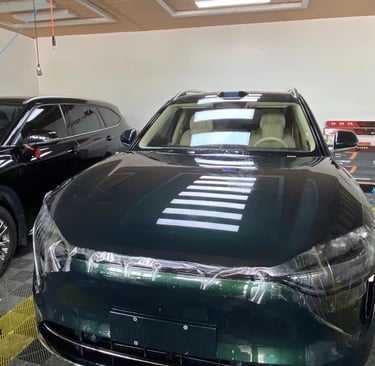The Essential Difference Between PPF and Color Change Films: A Wholesaler's Guide
Blog post description.
7/27/20252 min read


Introduction
In the automotive film wholesale industry, Paint Protection Film (PPF) and Color Change Films are often confused, but they differ fundamentally in material properties, applications, and market positioning. As a wholesaler, understanding these key distinctions helps you optimize inventory, make informed purchasing decisions, and provide expert advice to downstream clients.
This article systematically compares the two films across material composition, performance parameters, and target markets, along with strategic purchasing recommendations for wholesalers.
1. Core Differences: Material Structure & Protection Logic
1. Base Material Comparison
Property PPF (Paint Protection Film) Color Change Film Base Material Thermoplastic Polyurethane (TPU) PVC or Modified TPU
Primary Function Transparent Protection (Preserves OEM Paint) Color Alteration (Aesthetic Change)
Thickness Range 6-10mil 3-5mil
Elasticity High (200%+ Stretch) Medium (<150% Stretch)
Key Takeaways:
PPF’s TPU base offers self-healing properties (minor scratches disappear with heat).
Color change films (PVC-based) are stiffer, better for flat surfaces, but prone to yellowing.
2. Protection Mechanism
PPF:
Absorbs stone chip impacts via thickness.
UV/chemical-resistant top coat.
Color Change Film:
Provides minimal protection (1-2 years).
Scratches remain visible (no self-healing).
2. Performance Comparison
1. Durability Test Data
Test Premium PPF Standard Color Film
Accelerated Aging No yellowing after 5 years Fading starts at 2 years
Stone Chip Resistance Passes SAE J400 No certification
Chemical Resistance Resists gasoline, acid rain Only basic stain protection
2. Installation Requirements
PPF:
Requires precise cutting (plotter or hand-wrapping).
Demands clean-room conditions.
Color Change Film:
Allows panel-by-panel installation.
More forgiving (suitable for quick-service shops).
Wholesaler Tip: PPF sales should include installation guides, while color films need less support.
3. Market Positioning & Target Clients
1. Typical Applications
Scenario PPF Clients Color Film Clients
Luxury Cars OEM dealership add-ons Customization enthusiasts
Commercial Fleets Corporate vehicle protection Ride-hailing temp upgrades
Used Car Refurbishment High-value paint restoration Budget refurbishments
2. Purchase Cycles & Profit Margins
PPF:
Longer decision cycles (clients deliberate carefully).
30-50% gross margin (higher for premium grades).
Color Films:
High repeat purchases (replacement every 2-3 years).
20-35% gross margin (volume-driven).
Inventory Strategy:
Stock 60% 8mil PPF (most popular).
Allocate 70% of color films to trending shades (e.g., electric gray, crystal blue).
4. FAQ for Wholesalers
Q: Can color films replace PPF for protection?
A: No! Color films lack thickness to absorb impacts and may damage paint long-term.
Q: How to explain "TPU color films" vs. standard ones?
Highlight:
TPU films cost 2-3x more than PVC.
Last 5+ years (vs. 2 years for PVC).
Target high-end shops/luxury clients.
Q: How to handle product complaints?
PPF issues: Often installation-related (lifting/bubbles) → Provide technical support.
Color film issues: Fading/cracking → Check batch quality.
5. Purchasing Checklist for Wholesalers
Evaluation Criteria PPF Focus Areas Color Film Focus Areas Warranty Documents10-year warranty + yellowing tests 2-year warranty + colorfastness reports
MOQ Typically 50+ rolls (lower for custom colors) Mixed-color orders (20+ rolls) Support Materia lsInstallation videos/manuals Basic documentation
